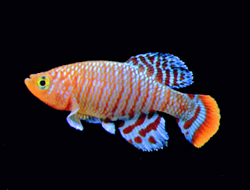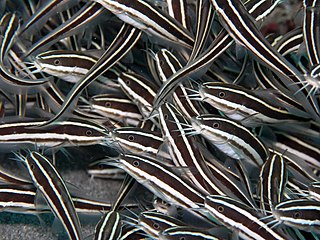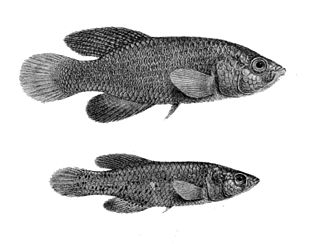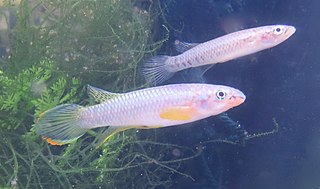
A killifish is any of various oviparous (egg-laying) cyprinodontiform fish. All together, there are 1,270 species of killifish, the biggest family being Rivulidae, containing more than 320 species. As an adaptation to living in ephemeral waters, the eggs of most killifish can survive periods of partial dehydration. Many of the species rely on such a diapause, since the eggs would not survive more than a few weeks if entirely submerged in water. The adults of some species, such as Kryptolebias marmoratus, can additionally survive out of the water for several weeks. Most killies are small fish, from 2.5 to 5 cm, with the largest species growing to just under 15 cm.

Nothobranchius is a genus of small, freshwater killifish, classified in either the family Nothobranchiidae or a more inclusive Aplocheilidae in the order Cyprinodontiformes. There are many species: as of 2018 there are more than 70 species, many with very small distributions. They are primarily native to East Africa from Sudan to northern South Africa, but half a dozen species are found in the upper Congo River Basin and two species are from west-central Africa; the greatest species richness is in Tanzania.

The blue panchax or whitespot is a common freshwater fish found in a large variety of habitats due to its high adaptability. This species is native to southern Asia from Pakistan to Indonesia. It has been discovered in two hot springs in Singapore. Identified by a white-coloured spot on its head, the species can reach up to 9 cm (3.5 in) in length; it tends to keep to the surface of the water, and controls the mosquito population by feeding on their larvae.

Aplocheilidae, the Asian killifishes or Asian rivulines, is a family of fish in the order Cyprinodontiformes found in Asia. Some authorities use this family-group name, which is well-established, for a single lumped aplocheiloid family as it gives the nomenclature stability over time and avoids the impact of a new name at family rank for a popular aquarium fish group. Following this proposal, Aplocheilidae would include three subfamilies: Aplocheilinae for the species from Asia, Madagascar and the Seychelles; Cynolebiinae for the species from the Americas; and Nothobranchiinae for the species from the African mainland. However, the 5th edition of Fishes of the World still classifies these as separate families, and at least one 2008 study suggests that even the narrow Aplocheilidae may not be monophyletic, with Aplocheilus itself possibly being basal to all other Cyprinodontiforms and thus only distantly related to the younger Pachypanchax.

The striped panchax is a species of killifish, of the genus Aplocheilus. An aquarium variant of this species with a more yellowish coloration is known as golden wonder killifish. The striped panchax inhabits fresh and brackish waters of India and Sri Lanka. It is found in streams, rivers, swamps, and paddy fields. This fish grows to a length of 10 cm (3.9 in).

Pachypanchax playfairii, the golden panchax, is a species of Aplocheilid killifish, the only species of freshwater fish endemic to the Seychelles, a group of islands in the Indian Ocean directly east of Tanzania, and the only member of its genus found outside of Madagascar. Within the Seychelles it is found only on the granitic islands. Here it occurs in small freshwater and brackish water streams, feeding on worms, crustaceans, insects and fish. An egg scatterer, the golden panchax breeds amongst floating water plants. This species is unusual in that the scales of the male become lifted during the breeding season, giving the skin a rough appearance. Unlike the true annual killifish, they live as long as similar fishes, a few years, 3 years is not uncommon 5 is unknown.

Plotosus is a genus of eeltail catfishes native to the Indian Ocean, the western Pacific Ocean and New Guinea.

The spotted killifish is a small, short lived species of fish, an African rivuline from the family Nothobranchiidae. These fish are native to many isolated freshwater pools located in the savannah depressions of east Africa, specifically Malawi, Mozambique, Zimbabwe, and South Africa. This species of fish occurs in ephemeral waters and killifish eggs can survive long periods of dehydration. The word killifish likely comes from the Dutch kil for kill.

Pachypanchax omalonotus, the powder-blue panchax, is a species of Aplocheilid killifish endemic to Madagascar where it is found on the island of Nosy Be and in the Sambirano River basin and adjacent streams on the mainland. Its natural habitat is rivers.

Rivulus is a genus of small freshwater fish in the Cyprinodontiformes family Rivulidae. It was traditionally considered to be the largest genus in its family; however, the genus's size is currently in dispute. Wilson J. E. Costa split this genus into several new genera in 2004 and 2011, leaving only a few Greater Antillean species in Rivulus itself. Despite being moved to other genera, some of the species retain the common name "rivulus", like the well-known mangrove rivulus. Shortly after the review by Costa, another review authored by J.H. Huber refuted the split, moving the proposed genera back in Rivulus and again making the genus the largest in the family Aplocheilidae.

Heterandria is a genus of livebearing fishes within the family Poeciliidae. Most species occur in Guatemala and its surroundings, particularly Mexico, but the midget livebearer (H. formosa) comes from the southeastern United States.

Profundulus is a genus of fish in the family Profundulidae endemic to Mexico and northern Central America. According to many authorities, including Fishbase this is the only genus in the Profundulidae but workers have split the genus and raised a second genus Tlaloc.

Meiacanthus is a genus of combtooth blennies found in the western Pacific and Indian oceans. Many species in this genus make their way into the aquarium trade and several are venomous. The genus name Meiacanthus is derived from the Greek meion meaning "less" and akantha meaning "thorn" and refers to most species having relatively few dorsal fin spines.

Surface wave detection by animals is the process by which animals, such as surface-feeding fish are able to sense and localize prey and other objects on the surface of a body of water by analyzing features of the ripples generated by objects' movement at the surface. Features analyzed include waveform properties such as frequency, change in frequency, and amplitude, and the curvature of the wavefront. A number of different species are proficient in surface wave detection, including some aquatic insects and toads, though most research is done on the topminnow/surface killifish Aplocheilus lineatus. The fish and other animals with this ability spend large amounts of time near the water surface, some just to feed and others their entire lives.

Fundulopanchax is a genus of killifish living in near-coastal fresh water streams and lakes in Western Africa. All species were previously biologically classified as members of the genus Aphyosemion, with the exception of Fundulopanchax avichang, F. gresensi and F. kamdemi, which were all scientifically described after the major revision of the Aphyosemion complex.

Aphyosemion is a genus of African rivulines endemic as the name indicates to Africa. Many of these species are popular aquarium fish.

Epiplatys is a genus of African rivuline in the family Nothobranchiidae endemic to Africa as the name indicates. Several of these species are popular aquarium fish.

Aphyosemion australe, the lyretail panchax, golden panchax or Cape Lopez lyretail, is a species of freshwater fish belonging to the family Aplocheilidae. It is found around Cape Lopez and in surrounding areas in Gabon.
Aplocheilus blockii or the green panchax is a species of fish native to waters around India, Sri Lanka, and Pakistan.


















